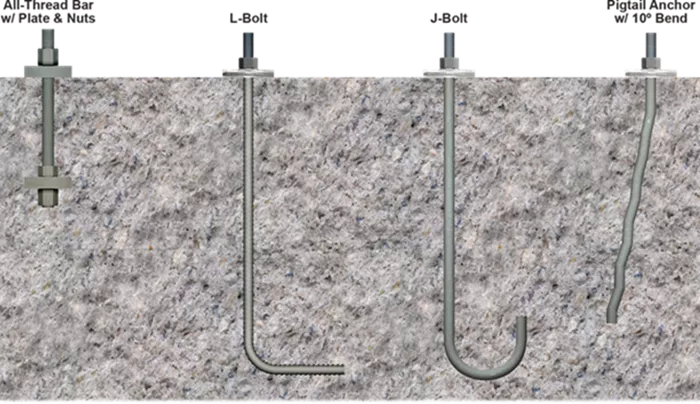Concrete anchors are essential components in construction and renovation projects, providing secure attachment points for various fixtures and fittings. Understanding the different types of concrete anchors, their applications, and installation methods is crucial for achieving reliable and durable results. This guide covers everything you need to know about concrete anchors, from the basics to advanced considerations.
1. What Are Concrete Anchors
Definition and Purpose: Concrete anchors are devices used to fasten or secure objects to concrete surfaces. They provide a reliable means of attaching items like shelves, fixtures, or machinery to concrete walls, floors, or ceilings. Anchors are designed to handle different loads and stress levels, depending on their type and installation.
Types of Concrete Anchors: Concrete anchors come in various types, each suited for specific applications and load requirements. Common types include:
Expansion Anchors: These expand against the sides of the drilled hole as the screw is tightened, providing a secure grip. Examples include wedge anchors and sleeve anchors.
Chemical Anchors: These use a resin or adhesive to bond the anchor to the concrete, offering high strength and resistance. Examples include epoxy anchors and polyester anchors.
Concrete Screws: Also known as tapcon screws, these are self-tapping screws designed specifically for use in concrete. They provide a simple and effective solution for lighter loads.
Hammer-Set Anchors: These are driven into pre-drilled holes using a hammer, expanding to grip the concrete. Examples include drive anchors and nail-in anchors.
2. Choosing the Right Concrete Anchor
Load Requirements: Determine the load that the anchor will need to support. Different anchors are designed to handle various weight capacities, so selecting the right one is crucial for safety and performance. Consult the manufacturer’s specifications for load ratings and ensure they match your project needs.
Concrete Type: Consider the type of concrete you are working with—whether it’s solid, hollow, or lightweight concrete. Some anchors are better suited for certain types of concrete. For example, expansion anchors work well in solid concrete, while chemical anchors are effective in both solid and hollow concrete.
Environmental Conditions: Evaluate the environmental conditions where the anchor will be used. Factors such as moisture, temperature fluctuations, and exposure to chemicals can affect the performance of anchors. For outdoor or harsh environments, select anchors made from corrosion-resistant materials or those designed for specific conditions.
Anchor Size and Installation: Choose the appropriate size of anchor for the hole diameter and depth. The installation method should also be considered, as some anchors require specialized tools or techniques. Proper installation ensures that the anchor performs as expected and provides a secure attachment.
See also: How Far Apart Should Studs Be For Optimal Support?
3. Installation of Concrete Anchors
Preparation: Before installing concrete anchors, ensure that the surface is clean and free of dust, debris, or grease. Use a drill with the appropriate bit size for the anchor and depth requirements.
Drilling Holes: Measure and mark the location for the anchor on the concrete surface. Use a hammer drill with a masonry bit to create holes of the correct diameter and depth. Ensure the holes are straight and clean to facilitate proper anchor installation.
Inserting the Anchor: Follow the manufacturer’s instructions for inserting the anchor into the drilled hole. For expansion anchors, insert the anchor and tighten the bolt or screw to expand it against the concrete. For chemical anchors, inject the resin into the hole before inserting the anchor and allow it to cure according to the instructions.
Securing the Fixture: Once the anchor is installed, attach the fixture or object to the anchor. Ensure that the fixture is level and properly aligned before tightening any bolts or screws. Check the anchor’s performance to verify that it provides a secure hold.
4. Common Issues and Troubleshooting
Anchor Failure: If an anchor fails or doesn’t hold properly, it could be due to several factors, including incorrect installation, overloading, or unsuitable anchor type. Review the installation process and load requirements to identify any issues and correct them.
Cracking Concrete: Improper drilling or excessive force during installation can cause cracks in the concrete. If cracks are observed, assess their impact on the anchor’s performance and consider using a different type or method of anchoring.
Anchor Corrosion: In environments prone to moisture or chemicals, anchors may corrode over time. To prevent corrosion, use anchors made from stainless steel or other corrosion-resistant materials, and regularly inspect them for signs of damage.
5. Maintenance and Inspection
Regular Checks: Periodically inspect concrete anchors to ensure they remain secure and in good condition. Look for signs of wear, rust, or loosening, and address any issues promptly to maintain safety and reliability.
Cleaning: Keep anchors and the surrounding concrete surface clean to prevent buildup of debris or corrosive substances. Use appropriate cleaning methods based on the environmental conditions and type of anchor.
Replacing Damaged Anchors: If an anchor shows signs of damage or reduced performance, replace it with a new one. Ensure that the replacement anchor is suitable for the load requirements and installation conditions.
Conclusion
Concrete anchors are vital tools for securing fixtures and equipment to concrete surfaces. Understanding the types of anchors, choosing the right one for your needs, and following proper installation and maintenance procedures are essential for achieving reliable and durable results. By evaluating your project requirements and selecting the appropriate anchor, you can ensure that your construction or renovation work is safe, secure, and long-lasting.
Related Topics:

